10 Examples for Cold Emailing & Why They Work [2022]
Sophia Seltenreich
Contents
- What is Cold Emailing?
- 1. Before-After-Bridge (BAB)
- 2. Problem-Agitate-Solve (PAS)
- 3. But You Are Free
- 4. Star-Chain-Hook
- 5. Attention – Interest – Desire – Action (AIDA)
- 6. Star-Story-Solution
- 7. The
- 8. The 3-B Plan
- 9. Praise-Picture-Push (3P’s)
- 10. Awareness-Comprehension-Conviction-Action (ACCA)
- Bottom Line: Cold Emailing is Simple
Pop quiz. What is the number one goal of cold emailing?
To get your email read.
Makes sense, right?
So what’s the primary goal of your first sentence?
The surprisingly simple answer is…to get the second sentence read.
Each line of a cold call email must persuade the reader to read the next one, all the way through to your close.
Good news: There are proven formulas for that.
For years copywriters have used basic scientific principles of persuasion and influence to come up with a number of writing techniques that reliably draw readers into their content.
These formulas just plain work – and can stop people in their tracks and compel them to read your cold email.
Below are the top ten formulas we’ve come across, as seen in real-world cold email examples from Yesware sales reps and others. Give them a try and see how they might improve your reply rates.
What is Cold Emailing?
Cold emailing is the act of sending an email to someone you don’t know in hopes of building a business relationship.
The email is “cold” if you haven’t had any prior contact with the recipient and there is no relationship yet.
Cold emailing is tough, but when done right, you can dramatically level up your sales outcomes.
Now, let’s look at proven cold emailing formulas that generate results and build relationships.
1. Before-After-Bridge (BAB)
Before — Here’s your world now
After — Imagine what the world would be like if you solved this problem
Bridge — Here’s how to get there
Open your personalized email by describing a problem that is relevant to your prospect, and then describe how the world would be different if that problem didn’t exist. Close by explaining how your product/idea/service can help them get there.
Why it works: According to behavioral psychologists, humans are motivated to take action by two things: pleasure and pain. The BAB formula uses this universal trigger to compel readers to respond.
Example: Here’s an email that was sent our way by a rep (real name changed) from Xactly.
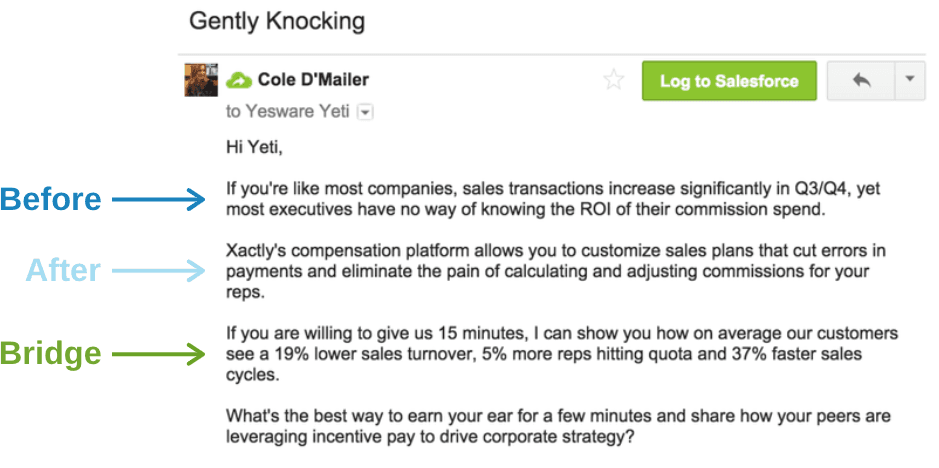
2. Problem-Agitate-Solve (PAS)
Problem — Identify a pain point
Agitate — Agitate that pain point
Solve — Offer a solution
Instead of imagining life without the problem (the “After” stage), PAS calls out the dangers in the road from point A to B and explains how your product is the weapon they need to win.
Why it works: Because pain is even more motivating than pleasure. People want to avoid hassle, problems, and unnecessary burdens.
Example:
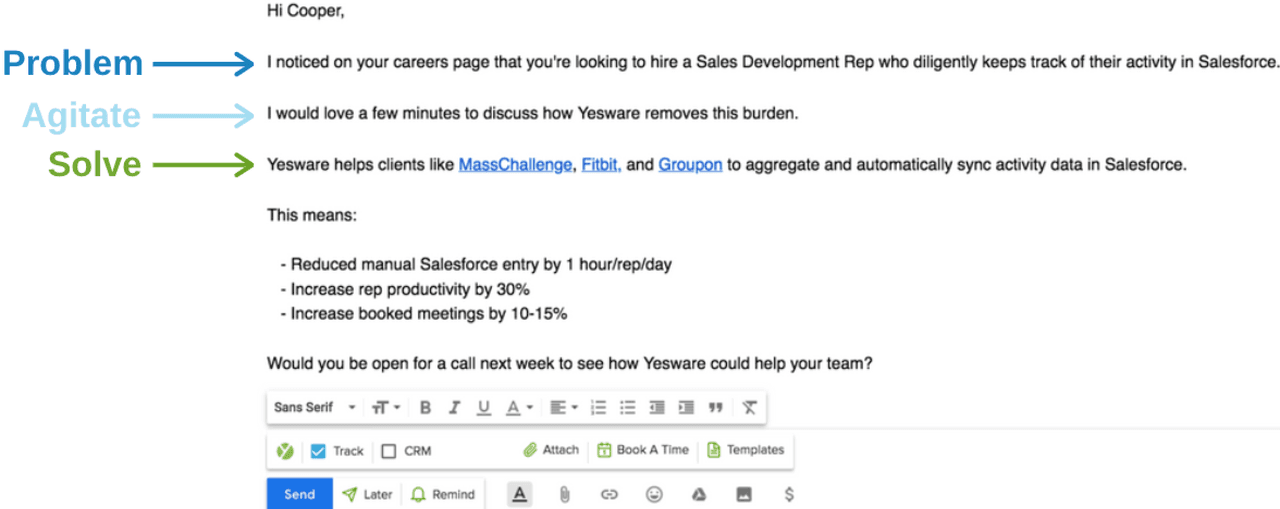
Tip: In a new 2020 study, we draw from hundreds of thousands of email activity over the last quarter to dissect the optimal time and day to send your cold emails based on reply rates.
3. But You Are Free
You’re looking at one of the most effective persuasion techniques out there. Make a request and then tell your prospect “but you are free” to do whatever they’d like.
Why it works: If you give someone a way out, it will double the chance that they say yes. This practical persuasion tactic is supported by 42 psychological studies on over 22,000 people.
Example:
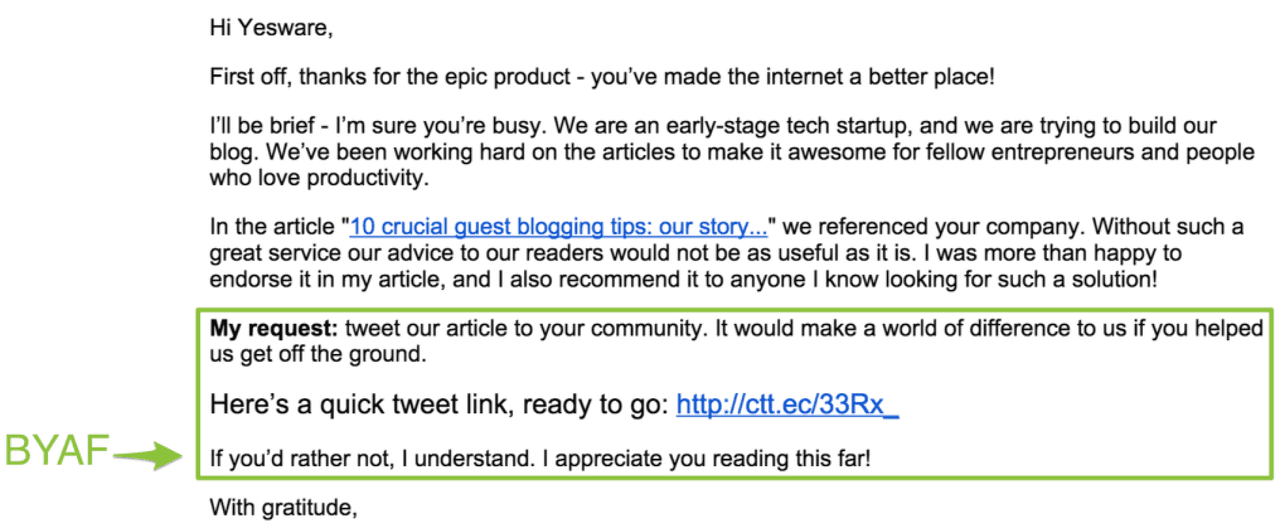
4. Star-Chain-Hook
Star — The big idea
Chain — A series of facts, sources, reasons, and benefits
Hook — The call to action
Introduce your idea with an attention-grabbing opening. Create a chain of supporting facts, sources, and benefits to build credibility and transform attention into interest. Then, hook them with a call to action that makes it easy to take the desired next step.
Why it works: The key element in this cold email outreach formula is the chain. By introducing proof points that lend credibility to your argument, you have a better shot at convincing someone to follow through.
Example: This cold call email was sent to us by someone (real name changed) at Conga Composer.
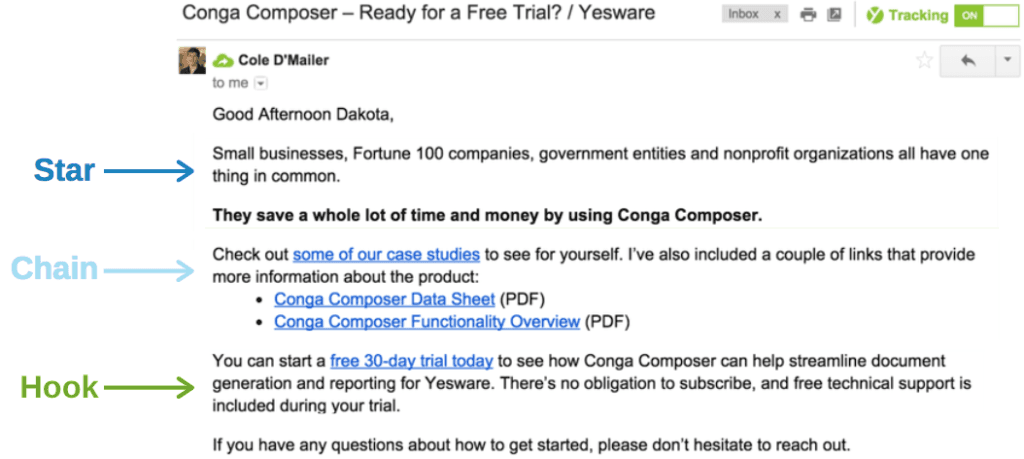
To improve this method further, you can utilize email tracking to get real-time data on how prospects are engaging with your call to action.
5. Attention – Interest – Desire – Action (AIDA)
Attention — Grab the reader’s attention.
Interest — Make it personal to engage their interest.
Desire — Build desire for what you’re offering.
Action — Ask for a response.
Why the cold email example below works:
- Attention: The subject and opening line pull the reader in by asking a relevant and important question (here are some top-performing cold email subject lines).
- Interest: It piqued her interest by providing statistics on why she should engage.
- Desire: FOMO. The fear of missing out on something increases our desire for it.
- Action: There’s a clear direction on what she should do after reading the email.
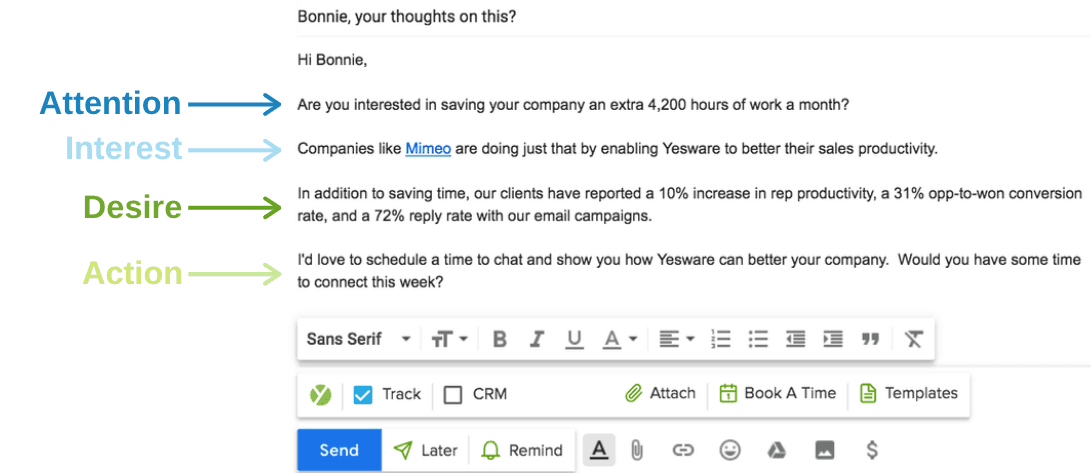
6. Star-Story-Solution
Star — The main character in your email. It could be you, your prospect, a product, etc.
Story — Talks about how the star faces the same problem your market does.
Solution — An explanation of how the star wins in the end.
Why it works: When we read a story, our brain acts as if we’re living it.
That’s because the brain does not make much of a distinction between reading about an experience and encountering it in real life. In each instance, the same neurological regions are stimulated.
Storytelling in sales can help your reader quickly wrap their head around the idea you’re to sell them. Used in cold emails, you’ll engage their attention and create an emotional connection that makes it easier to reply.
Example: This is the email used by an employee that successfully landed her a job at Yesware. The rest is history.
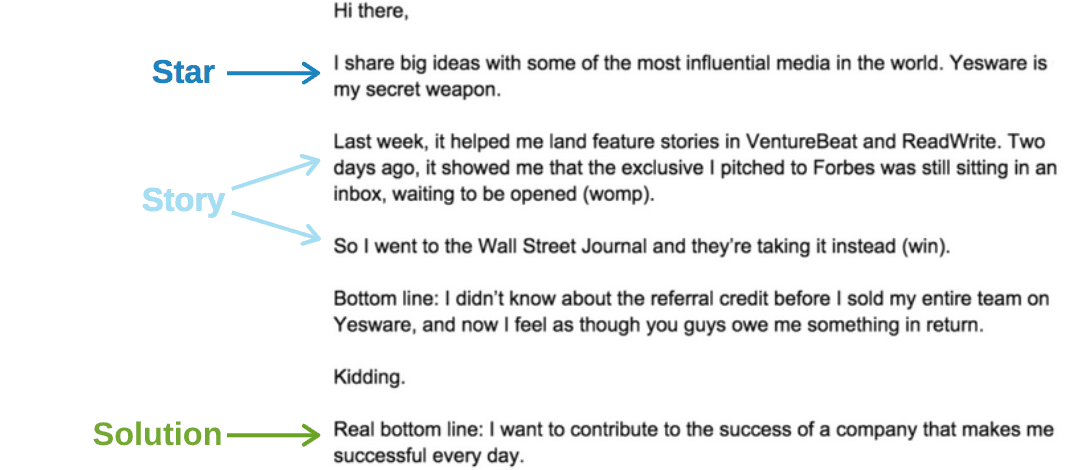
7. The Reader’s Digest Model
In 1961, legendary copywriter John Caples analyzed Reader’s Digest to find its secrets for hooking readers in the opening paragraph. He found that the most-successful articles:
- Are fact-packed
- Are concise
- Are specific
- Contain few adjectives
- Arouse curiosity
Why it works: A compelling introduction email makes the difference whether your email gets a reply or passed over.
Example: This email from Yesware Business Development Associate, Dakota McKenzie, used many of these key elements to grab his prospect’s attention. (It also made a lasting impression.)
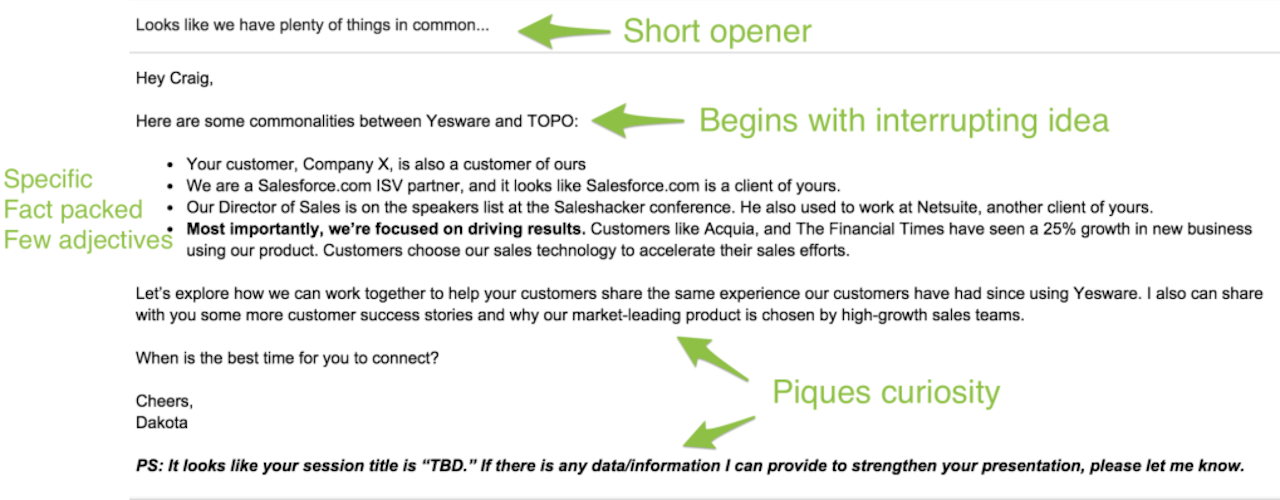
8. The 3-B Plan
Brevity — Keep it short.
Blunt — Get to the point.
Basic — Keep it simple.
From Gregory Ciotti of Help Scout, this cold email technique is similar to the Reader’s Digest model, giving the reader a clear sense of who you are and what you want from them. He adds this key element: Be blunt.
Being blunt doesn’t mean not being persuasive, it simply means getting to the point without trying to be clever. Stories and jokes are essential for other forms of writing, but NOT for emails. Get to the incentive on why the other person should respond right away.
Why it works: Studies show that shorter emails result in quicker response time. If you make someone actually think about what you’re asking, it’s just another item on their to-do list.
Example:
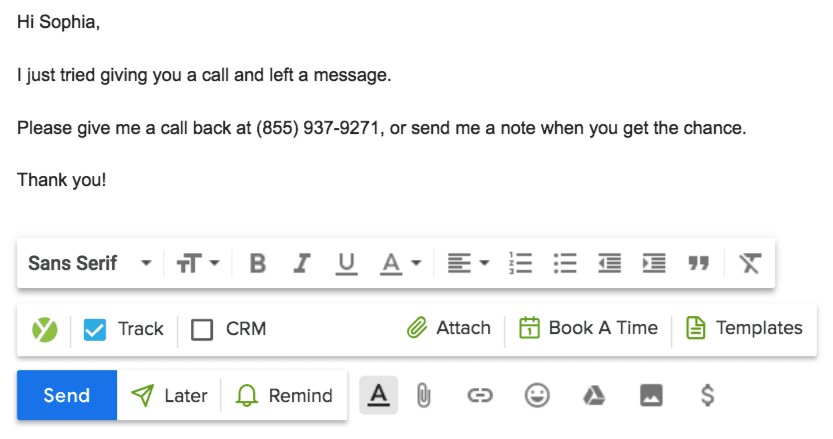
9. Praise-Picture-Push (3P’s)
Praise — Open with a sincere, respectful compliment.
Picture — Use cause-and-effect reasoning to paint a picture describing how your product/service/idea will deliver.
Push — Ask them to commit.
Why it works: The “3P” cold email formula is rooted in psychology.
- Praise — To the brain, receiving a compliment is as much a social reward as receiving cash.
- Picture — Studies show that when a person explains cause-and-effect, it builds trust and lends more weight to their argument.
- Push — Explain some, but not all, of what the reader will get if they respond. It’s what we don’t know that makes us want to investigate, discover, and agree to learn more.
Example:
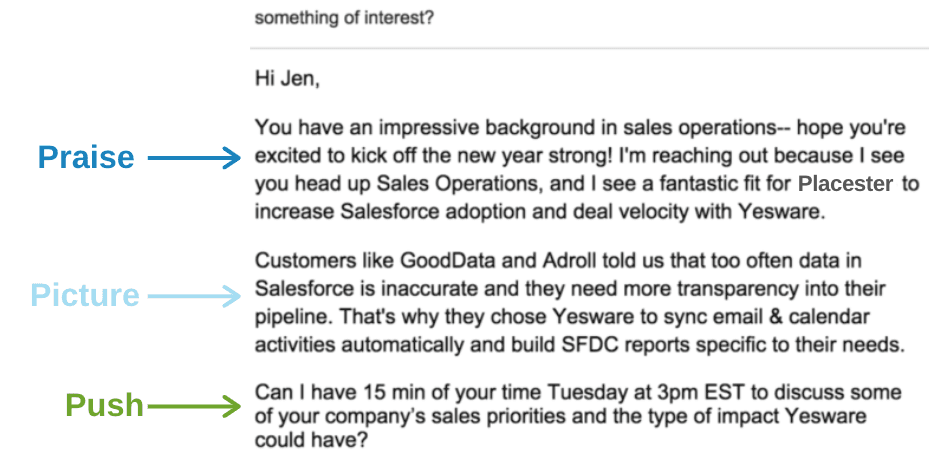
10. Awareness-Comprehension-Conviction-Action (ACCA)
Awareness — Present the situation or problem.
Comprehension — Describe how it will impact them.
Conviction — Create desire by explaining how your solution fixes the problem.
Action — Ask for a response.
Why it works: This method may seem similar to the AIDA model, but the “Comprehension” and “Conviction” aspects drive home the importance of clarity while suggesting certainty.
Example:
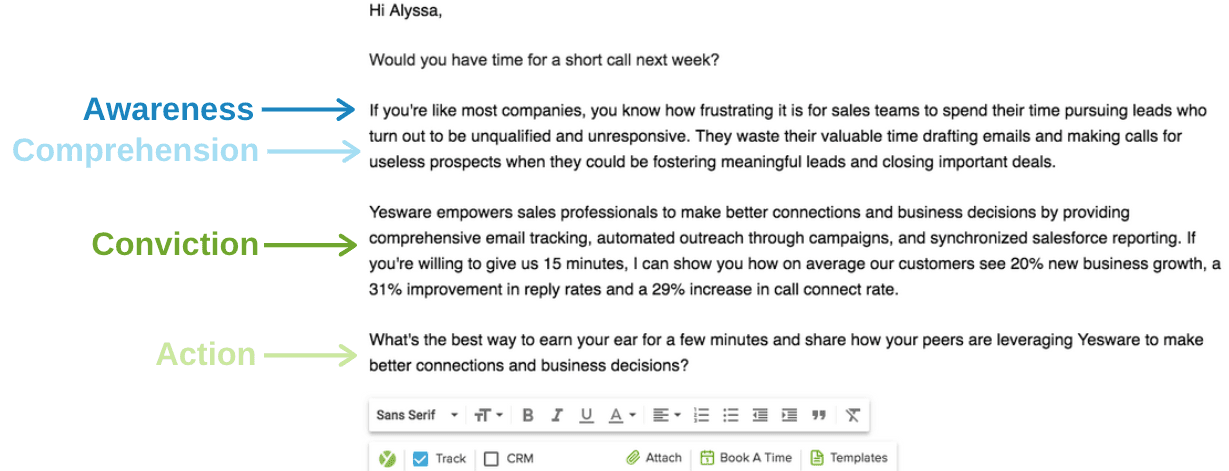
Bottom Line: Cold Emailing is Simple
These copywriting formulas for cold emailing have been tested and proven to mesmerize, captivate, and persuade all types of audiences.
Find a formula that works with your prospects, and save it as a cold email template to reuse when you need it.
Get sales tips and strategies delivered straight to your inbox.
Yesware will help you generate more sales right from your inbox. Try our Outlook add-on or Gmail Chrome extension for free, forever!
Related Articles
Jenny Keohane
Jenny Keohane
Melissa Williams
Sales, deal management, and communication tips for your inbox
![10 Examples for Cold Emailing & Why They Work [2022]](/blog/_next/image/?url=https%3A%2F%2Fwww.yesware.com%2Fwp-content%2Fuploads%2F2019%2F04%2FiStock-1031398222.jpg&w=1984&q=75)
